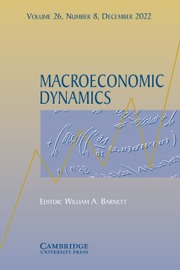No CrossRef data available.
Article contents
Shadow banking, implicit guarantees, and risk-taking
Published online by Cambridge University Press: 24 November 2025
Abstract
This paper investigates the welfare implications of the rise of shadow banking in China, driven by regulatory arbitrage and implicit guarantees. Although shadow banking can improve social welfare by relaxing constraints on banks’ capacity to expand credit, it may also hurt social welfare due to the risk-taking behavior induced by implicit guarantees. We study the optimal level of guarantees and shadow banking in a model that balances these benefits and costs. Our findings suggest that reducing the existing degree of guarantees and shrinking the shadow banking sector could enhance social welfare in China.
Information
- Type
- Articles
- Information
- Copyright
- © The Author(s), 2025. Published by Cambridge University Press
References
Abbate, A. and Thaler, D.. (2019) Monetary policy and the asset risk-taking channel. Journal of Money, Credit and Banking 51(8), 2115–2144.10.1111/jmcb.12621CrossRefGoogle Scholar
Acharya, V. V., Gale, D. and Yorulmazer, T.. (2011) Rollover risk and market freezes. Journal of Finance 66(4), 1177–1209.10.1111/j.1540-6261.2011.01669.xCrossRefGoogle Scholar
Acharya, V. V., Qian, J. Q., Su, Y. and Yang, Z.. (2024) Fiscal stimulus, deposit competition, and the rise of shadow banking: evidence from China. Management Science. 71(7), 5645–5675.10.1287/mnsc.2023.04233CrossRefGoogle Scholar
Allen, F. and Gu, X.. (2021) Shadow banking in China compared to other countries. Manchester School 89(5), 407–419.10.1111/manc.12331CrossRefGoogle Scholar
Allen, F., Gu, X., Li, C. W., Qian, J. Q. and Qian, Y.. (2023) Implicit guarantees and the rise of shadow banking: the case of trust products. Journal of Financial Economics 149(2), 115–141.10.1016/j.jfineco.2023.04.012CrossRefGoogle Scholar
Allen, F., Qian, Y., Tu, G. and Yu, F.. (2019) Entrusted loans: a close look at China’s shadow banking system. Journal of Financial Economics 133(1), 18–41.10.1016/j.jfineco.2019.01.006CrossRefGoogle Scholar
Bai, C. and Zhang, Q.. (2014) Rate of return to capital in China and the influencing factors. The Journal of World Economy 37(10), 3–30.Google Scholar
Bai, C.-E., Hsieh, C.-T. and Qian, Y.. (2006) The return to capital in China. Brookings Papers on Economic Activity 37(2), 61–102.10.1353/eca.2007.0000CrossRefGoogle Scholar
Chang, C., Liu, Z. and Spiegel, M. M.. (2015) Capital controls and optimal Chinese monetary policy. Journal of Monetary Economics 74, 1–15.10.1016/j.jmoneco.2015.04.003CrossRefGoogle Scholar
Chang, C., Liu, Z., Spiegel, M. M. and Zhang, J.. (2019) Reserve requirements and optimal Chinese stabilization policy. Journal of Monetary Economics 103, 33–51.10.1016/j.jmoneco.2018.08.005CrossRefGoogle Scholar
Chen, K., Ren, J. and Zha, T.. (2018) The nexus of monetary policy and shadow banking in China. American Economic Review 108(12), 3891–3936.10.1257/aer.20170133CrossRefGoogle Scholar
Chen, Z., He, Z. and Liu, C.. (2020) The financing of local government in China: stimulus loan wanes and shadow banking waxes. Journal of Financial Economics 137(1), 42–71.10.1016/j.jfineco.2019.07.009CrossRefGoogle Scholar
Cheng, I.-H. and Milbradt, K.. (2012) The hazards of debt: rollover freezes, incentives, and bailouts. The Review of Financial Studies 25(4), 1070–1110.10.1093/rfs/hhr142CrossRefGoogle Scholar
Dang, T. V., Wang, H. and Yao, A.. (2014) Chinese Shadow Banking: Bank-Centric Misperceptions. Working Papers 222014.Hong Kong Institute for Monetary Research.Google Scholar
Dang, T. V., Liu, L., Wang, H. and Yao, A.. (2019) Shadow Banking Modes: The Chinese versus US System. Working paper, Hong Kong Institute for Monetary Research.10.2139/ssrn.3491955CrossRefGoogle Scholar
Ehlers, T., Kong, S. and Zhu, F.. (2018). Mapping shadow banking in China: structure and dynamics. BIS Working Papers 701, Bank for International Settlements.Google Scholar
Gertler, M. and Kiyotaki, N.. 2011) Financial Intermediation and Credit Policy in Business Cycle Analysis. In Gertler, M. and Kiyotaki, N.. (eds.), Handbook of Monetary Economics, vol. 3. Elsevier, pp. 547–599.Google Scholar
Gertler, M. and Kiyotaki, N.. (2015) Banking, liquidity, and bank runs in an infinite horizon economy. American Economic Review 105(7), 2011–2043.10.1257/aer.20130665CrossRefGoogle Scholar
Gertler, M., Kiyotaki, N. and Prestipino, A.. (2016) Wholesale banking and bank runs in macroeconomic modeling of financial crises. In Gertler, M., Kiyotaki, N. and Prestipino, A.. (eds.), Handbook of Macroeconomics, vol. 2, chap. 16. Elsevier, pp. 1345–1425.10.17016/ifdp.2016.1156CrossRefGoogle Scholar
Gertler, M., Kiyotaki, N. and Prestipino, A.. (2020) Banking panics as endogenous disasters and the welfare gains from macroprudential policy. AEA Papers and Proceedings 110, 463–469.10.1257/pandp.20201022CrossRefGoogle Scholar
Gertler, M. and Karadi, P.. (2011) A model of unconventional monetary policy. Journal of Monetary Economics 58(1), 17–34.10.1016/j.jmoneco.2010.10.004CrossRefGoogle Scholar
Hachem, K. and Song, Z.. (2021) Liquidity rules and credit booms. Journal of Political Economy 129(10), 2721–2765.10.1086/715074CrossRefGoogle Scholar
He, Z. and Xiong, W.. (2012a:) Dynamic debt runs. The Review of Financial Studies 25(6), 1799–1843.10.1093/rfs/hhs004CrossRefGoogle Scholar
He, Z. and Xiong, W.. (2012b:) Rollover risk and credit risk. Journal of Finance 67(2), 391–430.10.1111/j.1540-6261.2012.01721.xCrossRefGoogle Scholar
Huang, J. (2018) Banking and shadow banking. Journal of Economic Theory 178(C), 124–152.10.1016/j.jet.2018.09.003CrossRefGoogle Scholar
Huang, J., Huang, Z. and Shao, X.. (2023) The risk of implicit guarantees: evidence from shadow banks in China. Review of Finance 27(4), 1521–1544.10.1093/rof/rfac061CrossRefGoogle Scholar
Levine, R. (2005) Finance and Growth: Theory and Evidence. In: Levine, R. (eds.), Handbook of Economic Growth, vol. 1, chap. 12. Elsevier, pp. 865–934.Google Scholar
Song, Z., Storesletten, K. and Zilibotti, F.. (2011) Growing like China. American Economic Review 101(1), 196–233.10.1257/aer.101.1.196CrossRefGoogle Scholar
Wang, H., Wang, H., Wang, L. and Zhou, H.. (2015) Shadow Banking: China’s Dual-Track Interest Rate Liberalization. Working paper. Tsinghua-PBC School of Finance.10.2139/ssrn.2606081CrossRefGoogle Scholar
Zhu, X. (2021) The varying shadow of China’s banking system. Journal of Comparative Economics 49(1), 135–146.10.1016/j.jce.2020.07.006CrossRefGoogle Scholar

